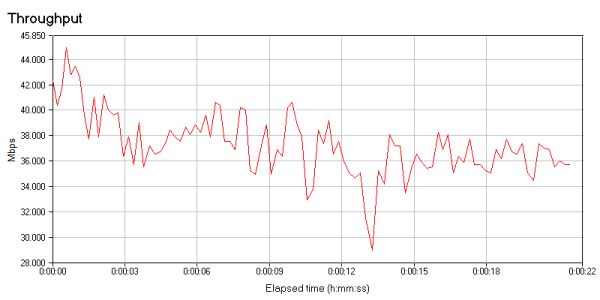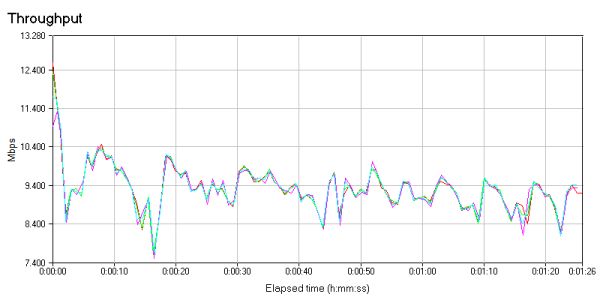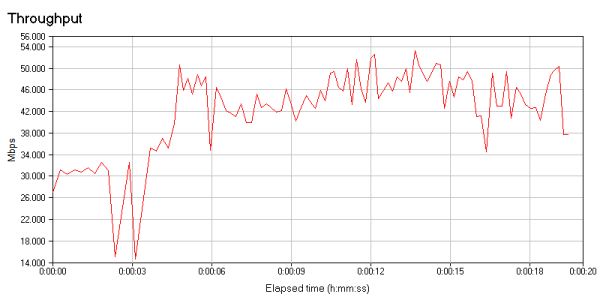Hands-On Powerline Networking: How Well (Or Not) Are Latest-Generation Devices Working?
by Brian Dipert on September 1, 2011 12:41 AM EST- Posted in
- Networking
- Powerline Adapters
- NetGear
The following table summarizes the abundant data I gathered across the 72 (and more...keep reading) tests, from one node combination to another, from one data-flow direction to another within a given node combination, and across the three adapter technologies that comprised this study:
| Average Bandwidth Testing Results (Mbps) | ||||||
| NETGEAR HomePlug AV1 | Sigma Designs HomePlug AV2 | NETGEAR IEEE 19013 | ||||
| Nodes | TCP (single-stream) | TCP (quad-stream) | TCP (single-stream) | TCP (quad-stream) | TCP (single-stream) | TCP (quad-stream) |
| 1->2 | 36.97 | 36.881 | 26.554 | 37.048 | 27.037 | 26.231 |
| 2->1 | 36.314 | 37.636 | 28.5 | 31.77 | 25.772 | 26.487 |
| 1->3 | 32.548 | 32.857 | 31.72 | 39.69 | 14.335 | 12.106 |
| 3->1 | 32.419 | 33.676 | 29.815 | 36.546 | 15.09 | 16.486 |
| 1->4 | 30.488 | 31.976 | 33.778 | 43.918 | 13.621 | 14.57 |
| 4->1 | 35.801 | 36.795 | 33.952 | 39.076 | 21.544 | 14.225 |
| 2->3 | 48.379 | 52.413 | 40.515 | 47.587 | 29.931 | 31.376 |
| 3->2 | 50.665 | 54.364 | 38.632 | 45.338 | 31.929 | 33.602 |
| 2->4 | 52.083 | 56.974 | 40.29 | 48.872 | 53.199 | 42.231 |
| 4->2 | 53.717 | 56.584 | 41.068 | 48.879 | 37.215 | 36.953 |
| 3->4 | 48.054 | 53.037 | 34.547 | 50.343 | 35.632 | 33.381 |
| 4->3 | 51.793 | 51.576 | 41.762 | 50.695 | 30.846 | 30.662 |
Nodes
- Dining room
- Living room
- Bedroom
- "Mud room"
Notes
- Firmware v0.2.0.5NA
- Firmware v1.2.15
- Firmware v0.2.0.9NA
Keep in mind that the table only shows only the average throughput across each test’s duration. Each single-number test summary omits per-stream average results for four-stream tests; the minimum and maximum per-stream and aggregate transfer rates across the test runtime; the overall transfer-rate pattern spread; and the measured minimum, maximum, average, and spread latency. The IxChariot reports embed all of this information and more. You can download a folder-delimited ZIP archive of all 72 report suites, in both native Ixia TST and exported TXT, PDF and HTML-plus-GIF formats, here.
In scanning over the data, you'll perhaps first notice that powerline network node 1 is the obvious bandwidth-compromised location. It's nearby the Dell XPS M1330, which acts as Media Center server for my Xbox 360s (acting as Media Center Extenders). Right now, I use a dedicated wide-channel 5 GHz 802.11n link to stream data from the laptop to my router. I'd originally thought that I could perhaps replace it with a powerline connection, thereby enabling me to (for example) simultaneously send multiple TV channels' worth of data to different game consoles. Guess not.
The Netgear XAV2001 (Qualcomm HomePlug AV) results closely align with those I've obtained in past studies using a number of different measurement schemes, giving me confidence both in this study's numbers and in my overall testing methodology. Note that the four-stream variant of each node-to-node TCP test delivered little to no incremental measured bandwidth versus the single-stream base case alternative.
That's not the case with the Sigma Designs-based HomePlug AV adapters. Although the single-stream results were respectable, they only exceeded those of the INT6400-based adapters in one of twelve cases. However, unlike with the INT6400-derived devices, the Motorola-branded HomePlug AV adapters showed consistent and significant speed improvements when I simultaneously sent four TCP streams through them, beating out the XAV2001s in five of twelve testing scenarios. Keep in mind, in comparing the Sigma Designs results with the others, that you're matching up a three-adapter Sigma Design topology against a five-adapter Netgear alternative...although in all three cases, only three adapters were in active use at any point in time (two Endpoint units, plus one at the router).
Finally, turn your attention to the AR7400-based Netgear XAV5001 IEEE 1901 adapters...and to the most baffling aspect of this study. In past testing, admittedly using different benchmark utilities and hardware configurations, the XAV5001s had exhibited consistent node combination-to-combination performance improvements over the XAV2001s, although the magnitude of the improvement varied depending on which specific node combination was being measured at the time. This time, on the other hand, the XAV5001s consistently undershot both adapter alternatives, and the XAV5001 four-stream testing setup even undershot the single-stream variant in a couple of cases.
I was so baffled by the outcome that I re-ran the XAV5001 tests several days later, obtaining a near-identical results set. I frankly don't know for sure what's going on, although I've seen similar discrepancies at other sites that have compared IEEE 1901 adapters to their HomePlug AV precursors. The last time I substantially tested the XAV5001 adapters, they were running the same firmware release as now, but it was springtime. Perhaps the overall power grid noise level is higher in late summer, or perhaps the higher ambient temperature caused a performance degradation; I've encountered similar scenarios in testing older-generation powerline technologies. Keep in mind, too, that the AR7400 is Qualcomm's first-generation IEEE 1901 chipset, versus the INT6400 third-generation HomePlug AV chipset, and that the associated AR7400 firmware is also comparatively immature.
One other Qualcomm-vs-Sigma Designs discrepancy bears mentioning. Check out these representative one- and four-stream testing bandwidth profiles from the Qualcomm AR7400 testing:
Now check out their Sigma Designs CG2110 counterparts:
Note that in the Qualcomm cases, bandwidth initially spiked high and then quickly tailed off to a steady-state value; the converse was the case with the Sigma Designs-based adapters.














53 Comments
View All Comments
claytontullos - Thursday, September 1, 2011 - link
I have a netgear XAV1004 -200 system set up for my ps3.When the main unit is on the same breaker as the receiver I get around 35Mb/s. When I had the unit setup a few breakers away I received around 3.1Mb/s. Making the change as made all the difference in the world as I could not stream HD content before.
You really have to take these 200Mb claims as a joke... my gigabit switch tells me the main unit is connected to it at 100Mb/s... You'd expect if it was truly capable of 200Mbs/ speed it would connect at the gigabit level.
bersl2 - Thursday, September 1, 2011 - link
Maybe it only implements Fast Ethernet, and marketing is adding Tx and Rx bandwidth together.fireboy92k - Thursday, September 1, 2011 - link
It's 100 Mbps full duplex (just like fast ethernet), hence the claim of 200 Mbps as you stat.See answer 10 at http://support.netgear.com/app/answers/detail/a_id...
bdipert - Thursday, September 1, 2011 - link
Thanks for writing, claytontullos. The '200 Mbps' (or for that matter, '500 Mbps') claims of the powerline folks are analogous to the '54 Mbps' and above claims of the Wi-Fi folks...or for that matter the '100 Mbps' and '1 Gbps' claims of the wired Ethernet folks. The peak theoretical PHY rate (or even close to it) is rarely if ever achievable in real-life usage environments, due to protocol overhead, distance- and otherwise-derived attenuation, destructive interference from other 'transmitters' in the same frequency bands, etc...p.s...'200 Mbps' powerline networking adapters usually if not always contain 100 Mbps wired Ethernet transceivers. 'Nuff said ;-) Note, however, that the XAV5001 '500 Mbps' adapters contain GbE transceivers...therefore making it important that I mated them to Endpoint systems (my MacBook and MacBook Pro) which ALSO have GbE capabilities
JarredWalton - Thursday, September 1, 2011 - link
I wouldn't lump the 100Mbps and 1Gbps Ethernet stuff in with the WiFi and Powerline networking. I routinely hit >100MBps transfer rates on my GbE setup, and basically peg any 100Mbps connections at 98% of their maximum throughput (around 12.3MBps). And that's using HDDs. Transferring files from an SSD-based system to another SSD over GbE, I can hit around 120MBps. Fastest I've ever managed on WiFi is around 30MBps with a "450Mbps" connection -- or around 53% of the theoretical rate.Per Hansson - Thursday, September 1, 2011 - link
Yea, I agree, don't talk down Ethernet like thatI have a 100mbps internet connection and I can routinely hit 12MB/sec transfer speeds...
I've also used those "Gigabit" Powerline networking devices and they managed an astonishing 5mbps throughput, while at the same time killing my FM reception on my radio, even the cars radio was interferred with when I tried it out to my garage (throughput was then ca 1mbps, somewhat shy of the 1000mbps claim...)
bdipert - Thursday, September 1, 2011 - link
Ok, ok, ok...so maybe I was a little harsh on wired Ethernet...;-) In this regard, a compare-and-contrast is perhaps of some value. Wired Ethernet is a media specifically designed to carry network packets. The AC power grid, on the other hand, or the atmosphere, in both cases with who-knows-what attenuators and spectrum contenders in-between transmitter and receiver...And even with wired Ethernet, protocol overhead (TCP's handshaking scheme, for example...this is why I REALY wished I could have gotten some meaningful UDP data in this study) will retard the effective transfer rate, even if the media and the transceivers on either end are up to the task. And speaking of the receiver, a slow NAS (for example) does a good job of putting the brakes on things, too...
el1x - Thursday, September 1, 2011 - link
As far as i am aware its 100Mbps Full Duplex and the marketing states the Tx & Rx together as bersl2 has said.Any chance of looking at the NetComm range of powerline? The NP202, 203, 204 & 206.
I have a set of the NP204's not only are they a solid reliable unit they have AC passthrough so i don't lose a power point.
jigglywiggly - Thursday, September 1, 2011 - link
The problem with this is that it isn't that much better than wifi, lol.akedia - Thursday, September 1, 2011 - link
My apartment is long, narrow, and fully of radiators. It's also over a century old, and power outlets are distressingly sparse and often tucked half-behind the radiators. Right now I have to have coax strung across half my apartment to get from the bizarre place the cable for my internet connection enters the wall to the only outlet in a good enough position to have my WiFi adapter plugged in and get a signal that's still only serviceable throughout half of my apartment. In a perfect environment, yeah, powerline and WiFi are comparable in performance. In reality, though, there are real advantages and disadvantages to each that can dramatically affect their relative utility. Lots of radiators... only one breaker.